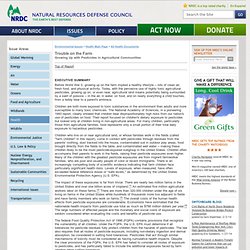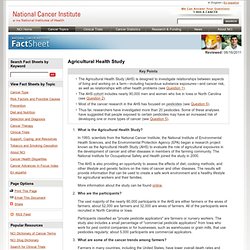

Cookies Disabled. Lu_evidence. Trouble on the Farm - Executive Summary. Top of Report Before World War II, growing up on the farm implied a healthy lifestyle -- lots of clean air, fresh food, and physical activity.

Today, with the pervasive use of highly toxic agricultural pesticides, growing up on, or even near, agricultural land means potentially being surrounded by a swirl of poisons -- in the air, in water, on food, and on nearly everything a child touches, from a teddy bear to a parent's embrace. Children are both more exposed to toxic substances in the environment than adults and more susceptible to many toxic chemicals. The National Academy of Sciences, in a pioneering 1993 report, clearly showed that children bear disproportionately high risks from our nation's use of pesticides on food.
Their report focused on children's dietary exposure to pesticides but looked only at children living in non-agricultural areas. The impact of these exposures is far from trivial. Findings Pesticides Around Us. Cancer. Children Living Near Agricultural Pesticide Use Have Higher Cancer Rate. (Beyond Pesticides, September 29, 2009) A new study reveals that children exposed to agricultural pesticides applied near their home have up to twice the risk of developing the most common form of childhood leukemia, according to the Northern California Cancer Center (NCCC).

The study, “Residential proximity to agricultural pesticide applications and childhood acute lymphoblastic leukemia,” published in the October issue of Environmental Research, used a unique California database to reveal an elevated risk in acute lymphoblastic leukemia (ALL) among children living near applications of certain categories of pesticides used in agriculture. The study, led by Rudolph Rull, Ph.D., shows an elevated risk of ALL associated with moderate exposure, but not high exposure, to pesticides classified as organophosphates (odds ratio (OR) 1.6), chlorophenoxy herbicides (OR 2.0), and triazines (OR 1.9), and with agricultural pesticides used as insecticides (OR 1.5) or fumigants (OR 1.7). Living near agricultural pesticide applications and the risk of adverse reproductive outcomes: a review of the literature - Shirangi - 2010 - Paediatric and Perinatal Epidemiology. Options for accessing this content: Type your institution's name in the box below.

If your institution is a Wiley customer, it will appear in the list of suggested institutions and you will be able to log in to access content. Some users may also log in directly via OpenAthens. Please note that there are currently a number of duplicate entries in the list of institutions. We are actively working on fixing this issue and apologize for any inconvenience caused. Registered Users please login: Access your saved publications, articles and searchesManage your email alerts, orders and subscriptionsChange your contact information, including your password. Cookies Disabled. Organophosphate pesticide exposure a... [Environ Health Perspect. 2006.
Symptoms. Cookies Disabled. An Error Occurred Setting Your User Cookie. How living near a farm is bad for your health. By SEAN POULTER, Daily Mail Last updated at 09:58 22 September 2005 Families living near farms could be in danger from the spraying of pesticides and other chemicals, an official inquiry has concluded.

In a highly-critical report, the Royal Commission on Environmental Pollution claims Government policies fail to protect the public. It says people who have reported ill-health are likely to be suffering the effects of chemical exposure. Inquiry chairman Sir Tom Blundell says: "Government policy on exposure of bystanders and local residents is currently inadequate. " The report argues for a "precautionary approach", including setting up no-spray buffer zones around fields. Its findings were last night welcomed by campaigners, who have linked chemical spraying to blistering, swollen throats, weeping eyes, ME and damage to the immune system. Some have even claimed a connection to cancer. Ministers and their advisers have previously suggested that claims of poor health are "all in the mind". AgricultureandCancer_001. Envi. Incident-factsheet. Agricultural Health Study.
What is the Agricultural Health Study?

In 1993, scientists from the National Cancer Institute, the National Institute of Environmental Health Sciences, and the Environmental Protection Agency (EPA) began a research project known as the Agricultural Health Study (AHS) to evaluate the role of agricultural exposures in the development of cancer and other diseases in members of the farming community. The National Institute for Occupational Safety and Health joined the study in 2000.The AHS is also providing an opportunity to assess the effects of diet, cooking methods, and other lifestyle and genetic factors on the risks of cancer and other diseases. The results will provide information that can be used to create a safe work environment and a healthy lifestyle for agricultural workers and their families.More information about the study can be found online.
Cookies Disabled. Ref98. Cookies Disabled.